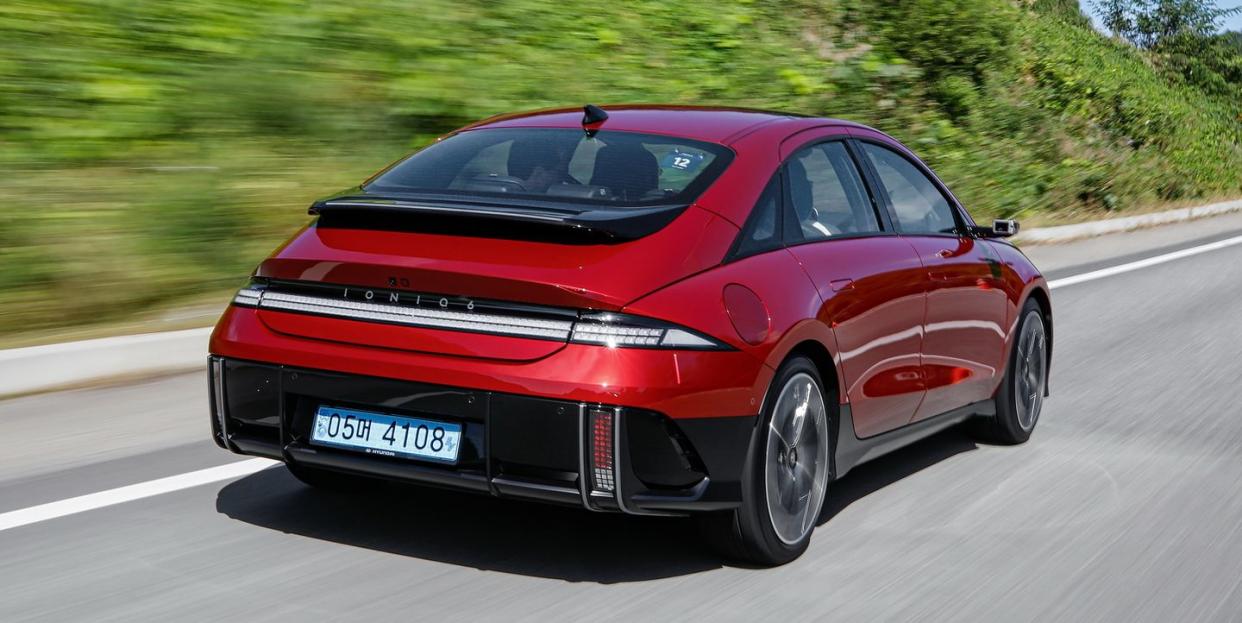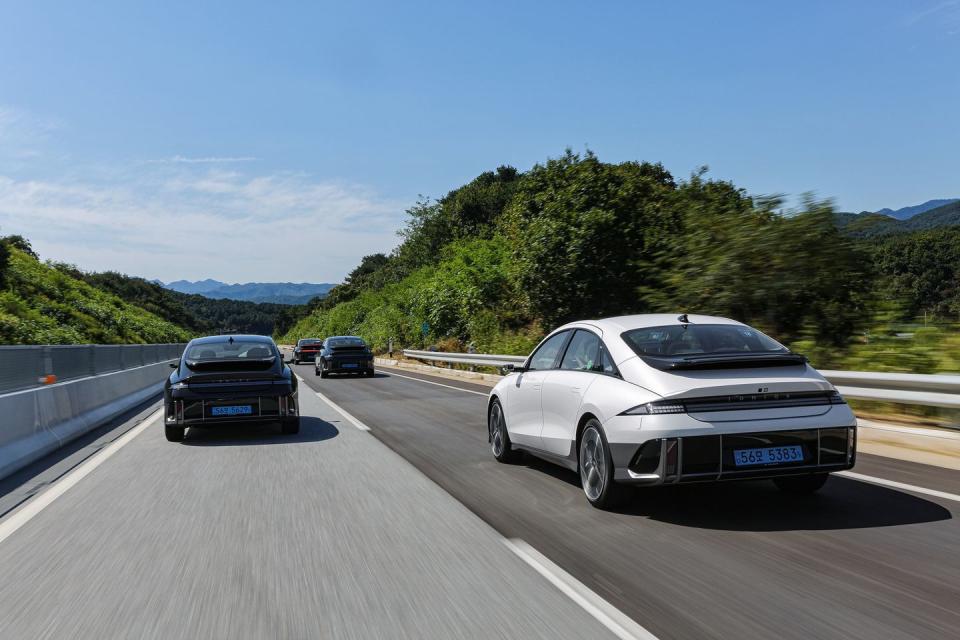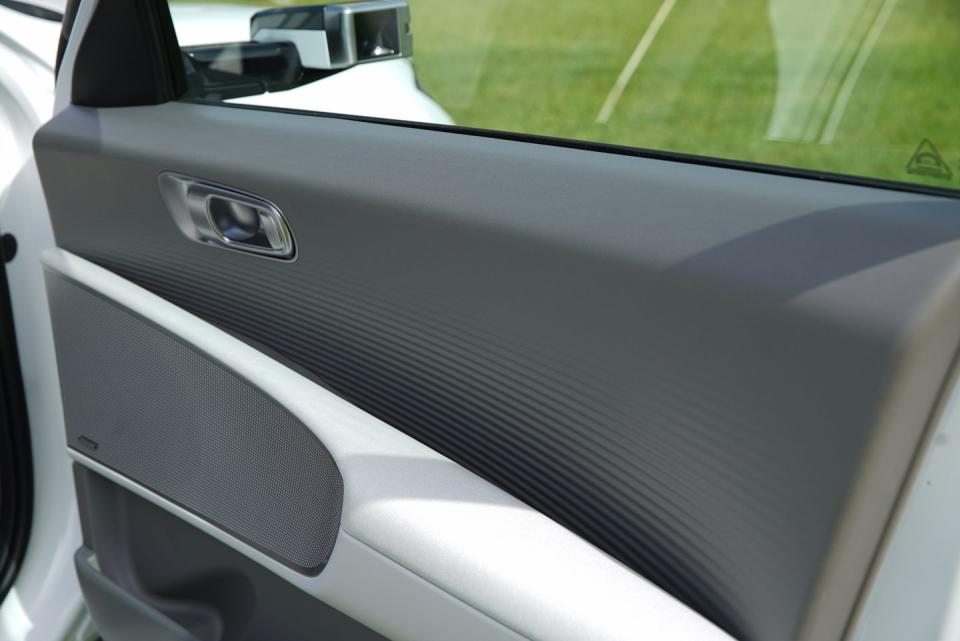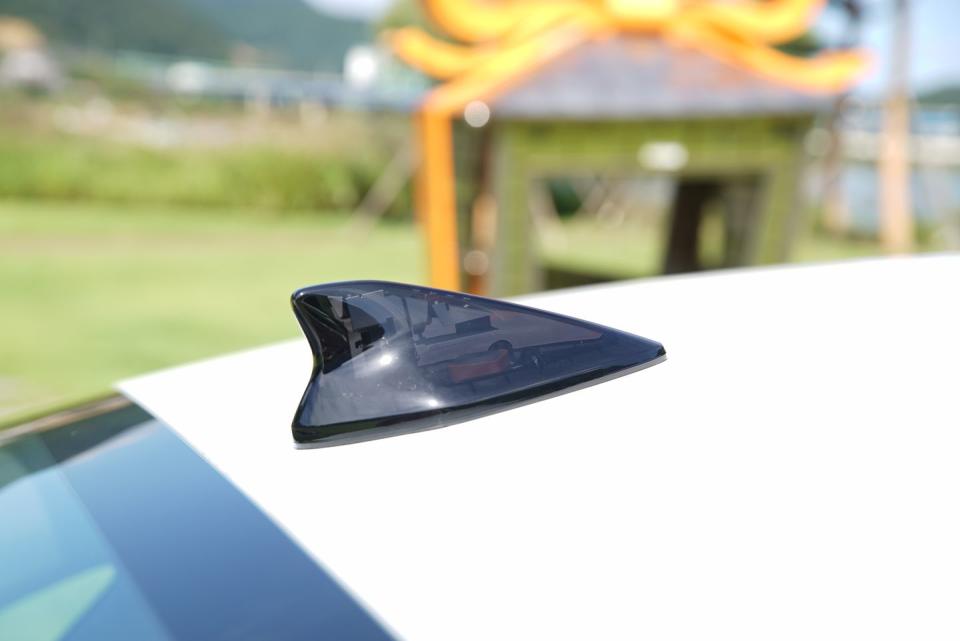The Hyundai Ioniq 6 Is the Electric Car For Design Nerds

After driving a bunch of electric cars, you notice a throughline. They tend to drive pretty similarly, and it’s hard to find defining driving characteristics between them. That’s particularly true for the new Ioniq 6, built on Hyundai’s Electric Global Modular Platform (E-GMP). It drives well, but not much different from its mechanically-identical sibling, the Ioniq 5. That meant Hyundai had to go all in on stand-out looks and fun design features to make this new sedan pop from the rest of the EV crowd.
The good news is, we’re big fans of the Ioniq 5. When we first reviewed it earlier in 2022, we called it “one of the best affordable electric cars yet.” Though we don’t have official word on pricing for the Ioniq 6, we’d bet that statement will carry over for the sedan as well. Thanks to an early (and very brief) drive session with some pre-production Ioniq 6s, there are some things we do know.
First off, this is a very solid-feeling EV. Our time with the Ioniq 6 consisted of a highway drive out of Seoul, South Korea, mostly in moderate traffic. Then, we explored some B roads at an unfast pace and returned to the metro area, fighting across packed lines while trying to follow the extremely wordy navigation guidance from Hyundai’s homegrown system. While none of this made for a satisfactory setting for a thorough test, the Ioniq 6 performed well at these simple, everyday tasks.

For these duties, I needed a normal car. Something easy to become familiar with, lacking excessive gizmos to be distracted by, and comfortable enough to keep me at ease while traversing a totally foreign roadway system. The Ioniq 6 nailed it. Our car, the long-range all-wheel-drive model, provided comfort, simplicity, and when called for, speed.
The electric sedan effortlessly put down its 320 horsepower when requested, whether I was testing its claimed 5.1-second 0-60 time from a standstill or getting on the right pedal to cut up highway gaps. For daily driving, there’s no need for anything more than what the Ioniq 6 is working with. The car’s steering and brakes—with adjustable regeneration—were fully within their comfort zone with this kind of driving. Unlike some of its EV competitors, like the Polestar 2, the Ioniq 6 doesn’t suffer from feeling like it’s extremely battery-heavy.

The interior is also extremely spacious and well put together. The backseat can comfortably fit full-size adults, thanks to the E-GMP’s flat-floor design and a surplus of legroom. Up front, controls are easy to navigate and for the most part, and the cabin’s materials are nice to the touch. There were two parts of the interior I wish I could erase from my memory, I will say. Those were its extremely plasticky door cards and unpleasant, cloth headliner. Hyundai, please rethink those two materials.

While there isn’t too much to focus on performance-wise from our quick drive, the Ioniq 6’s looks and design features are worth highlighting. The designers who crafted the sedan clearly spent a ton of time to make it stand out from the crowd visually and be very aerodynamic while doing so. Its design is both sleek and purposeful.
When Hyundai first announced the Ioniq 6 in June, we were immediately into it. Its looks follow and grow upon the retro vibes delivered by its hatchback sibling, allowing it to look strikingly different from most other cars on the market today. It’s clear Hyundai’s design team put in real hours when drawing this car together, and that they had fun doing so as well.

Our first look at what would become the Ioniq 6 came in March 2020 with the unveiling of the Hyundai Prophecy EV concept. Though the production-ready sedan has come a long way from that design, some parts of the concept were clearly essential to the 6’s final looks. Those being the spoiler, vertical rear bumper protection pads, headlight shape and obviously, the car’s very aerodynamic swoopy silhouette. Also, pixels. Hyundai’s designers made it very clear they love pixels.

“Unique beauty is about originality, and that's something that we work on very hard at Hyundai,” said Simon Loasby, the head of Hyundai’s style team. “We design each of our products with the future diverse lifestyles of our customers in mind.”
There are a handful of quirky design bits that stand out and are worth highlighting. Not only because they look cool, but also because they contribute to the car’s highly impressive .21 drag coefficient, a number that matches the industry-leading sleekness and air cutting of the far-more-expensive Lucid Air. But also, they just look cool.
Let’s go over those.

Yes, it has a see-through roof antenna. Exceedingly rad.
This spoiler is very 911-esque, and effective. Hyundai says it’s fixed because a power-deployable version would’ve been too heavy and expensive. Loasby also said the spoiler’s design was inspired by the Spitfire airplane wing, and that it’s the most important aerodynamic part of the car.

Pixels. Hyundai tried to hide pixels wherever it could on the new Ioniq 6. You’ll find them on exterior door buttons, the steering wheel, tail lights, in its logo, and surely elsewhere. Loasby said the pixel is core to Ioniq’s brand identity, and that Hyundai has taken special interest in the character because it’s also a letter in the Korean alphabet. There are apparently over 726 pixels on the Ioniq 6’s exterior.

Hyundai says the new sedan’s interior lighting is inspired by the aesthetic of Seoul at night. As much as that sounds like bullshit, after spending a few evenings in the city, it actually makes sense.

The Korean automaker says it designed the Ioniq 6’s center console in front to be flat across so the interior could easily be used as a laptop-friendly work station. While the seating position would make that a bit awkward, and most normal people would probably just put their computer on their lap, it’s a nice thought.
Honorary mention? Outside of the U.S., the Ioniq 6 can be equipped with a camera-to-screen setup to replace the conventional side-view mirrors. Though this isn’t a completely new technology, it is a fun one. They’re a bit annoying to get used to, but the design of the camera is impressive and adds to the sedan’s overall retro-futuristic aesthetic.
The Ioniq 6 has the bones to be a solid mid-range electric sedan and the looks of something that looks like it was designed with true care. With EVs becoming increasingly generic-feeling as more tumble onto the market, it's nice to have some that actually seem like some passion was involved when the clay models were first being shaped.
You Might Also Like

